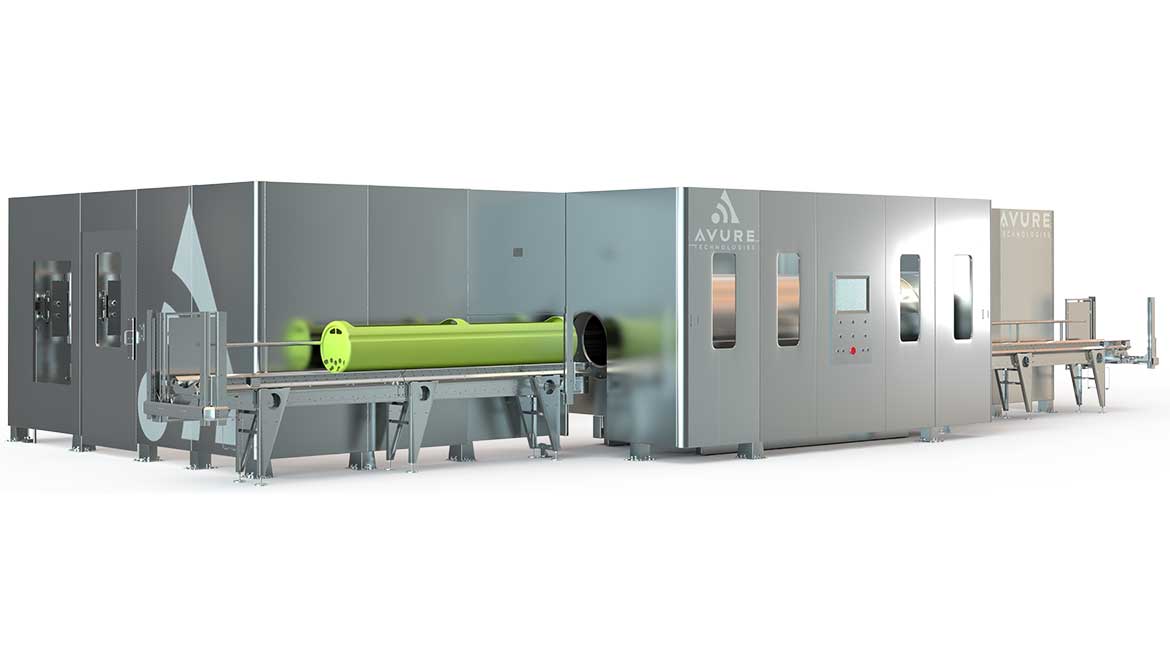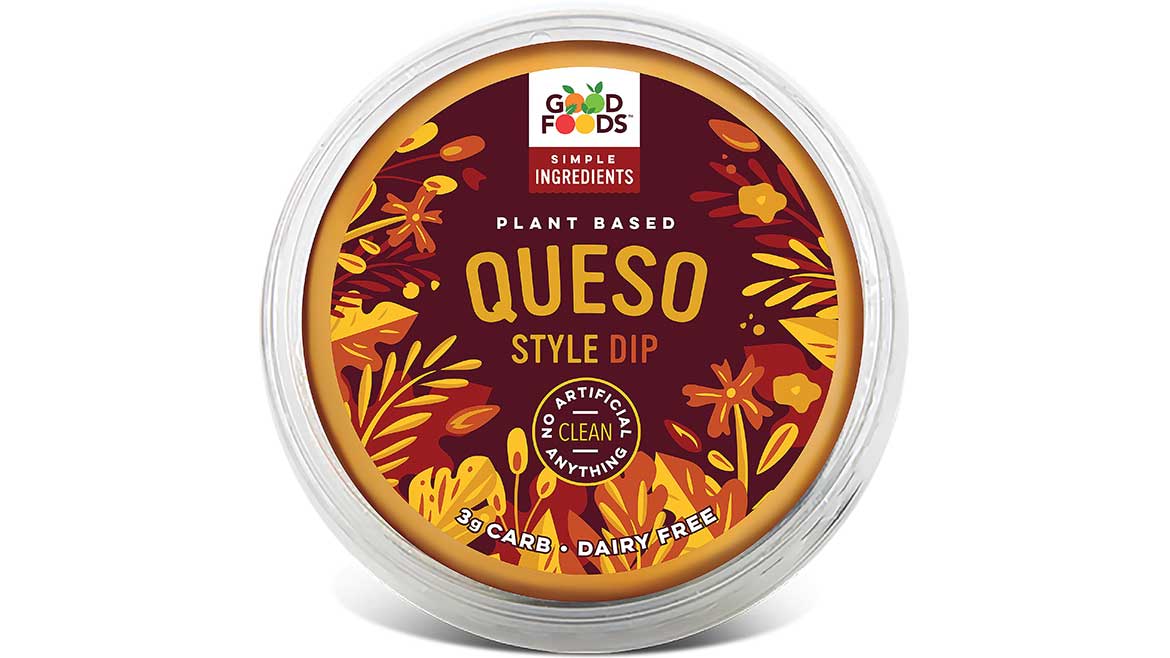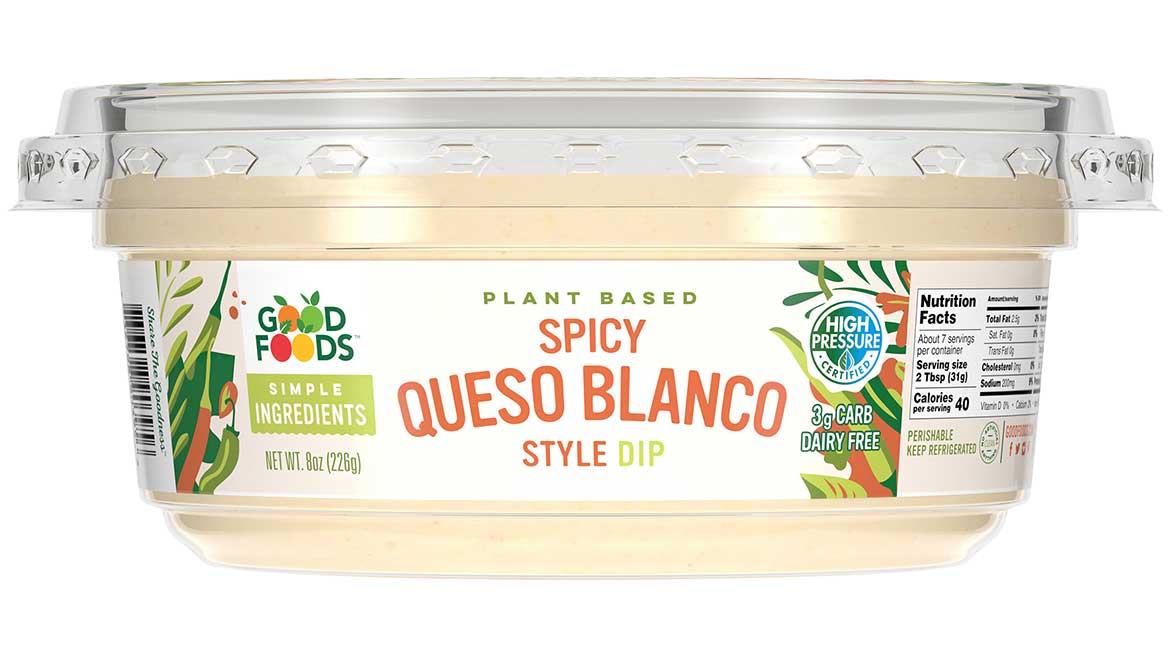Good Foods expanded its lineup of dairy-free, plant-based dips last fall for a double-digit increase in sales.
The company’s new Spicy Queso Blanco Style Dip joined its Original Queso Style Dip, which launched in 2019. The Spicy Queso Blanco flavor accounted for a 19% increase in sales of Good Foods’ plant-based dips.
The cauliflower-based queso dip is made with a blend of almonds, cashew butter, green chiles and jalapenos at a 110,000-square-foot facility in Peasant Prairie, Wisconsin. Once ingredients reach the Good Foods facility, they never break the cold chain. It takes about 30 minutes to produce a 500-pound batch of queso.
“We believe the future of exceptionally good food can be found in good ingredients and good people. Our award-winning R&D team works to formulate innovative clean products as our procurement group leverages their dedication to high quality ingredients, searching high and low to source the best raw materials grown by farmers who share our standards and passion,” said Danyel O’Connor, EVP of marketing and sales. “All products we produce strive to provide simple, safe, delicious food to consumers with vibrant kitchen-fresh flavor and no artificial anything.”
Founded in 2007, Good Foods uses High Pressure Processing (HPP) on its products to trade out poor nutrition and artificial ingredients. The HPP pasteurization technique extends the shelf life of Good Foods’ plant-based cheese dips from five weeks to 10 weeks.
“Once we have developed formulas and sourced natural and clean ingredients, we begin production by cleaning, sorting, measuring, and batching – much like in your kitchen mixer at home. Next we package our finished products nearly ready for sale. We then leverage the power of High Pressure Processing, placing the finished products in a water bath that endures pressure greater than that of 6 times the deepest point in the ocean,” said Joyce Longfield, principal of HPP applications. “So many consumers are shopping for pant-based alternatives - not because they are vegetarian or vegan. They are making a sustainability choice, not just a dietary choice.”
The Spicy Queso Blanco Style Dip is packaged in a variety of sizes, including 12, 24 and 32-ounce sizes and is available in bulk for foodservice.
HPP preserves food products by inhibiting microbial growth.
The HPP process inactivates bacteria such as Listeria, E. coli and Salmonella.
HPP products need high water content, be acidic & have a cold chain of distribution.
Consumers can look for the High Pressure Certified Seal for third-party verification.
Under Pressure
Unlike traditional heat methods, HPP is cold pasteurization using ultra-high pressure purified water to subject foods with up to 87,000 pounds of pressure per square inch. At this pressure, bacteria including Listeria, E. coli, and Salmonella are destroyed.
There is no impact on the HPP process with plant-based protein products. Generally, similar HPP conditions are used to process both animal and plant-based protein products.
“It interferes with the biochemistry of the organisms, depending on the time, pressure and type of food being subjected to HPP. With traditional processes, such as heat, consumers may get the same food safety benefits but with significant loss in nutrients, taste and flavor,” said Dr. Errol Raghubeer, senior VP of HPP & Food Science at JBTAvure, a maker of HPP machines used by Good Foods.
“HPP improves the safety, shelf life, nutrition and organoleptic properties of plant-based protein dips. Several HPP plant-based dips are on the market, including hummus, queso and other plant protein cheese dips, bean dips and avocado-based dips. Traditionally, these products contain high acids and chemical preservatives for food safety and shelf-life. HPP dips and spreads are now formulated with less acid and without chemical preservatives.”

The food and the organisms the manufacturer is trying to reduce or eliminate determines the amount of pressure and time. For example, juice products need about 75,000 PSI for 60 to 90 seconds to meet FDA requirements, but a cured meat product like prosciutto will need 87,000 PSI for upward of three minutes for the same microbial reduction.
Sometimes companies label their HPP products under a different brand but “one of the best ways to look at it is the absence of preservative. If it says ‘all natural’ and is absent preservatives, there’s a 99% chance it is an HPP product,” Ragubeer said.
The use of HPP is expected to grow, particularly in developing nations looking to introduce this “innovative shelf-life enhancement technique,” according to the study, “The Food High Pressure Processing (HPP) Technologies Market 2013-2023-Pascalization & Bridgmanization,” produced by London-based Vision Gain.


Emerging HPP categories include: refrigerated soups, baby food, pet foods and ready-to-eat meals.
In addition to its two plant-based cheese dips, Good Foods produces cold pressed juices, dressings, dips, salads, sauces and more. TThe company was a founding member of the Cold Pressure Council.
“The team at Good Foods has spent over 13 years specializing in developing foods that utilize HPP technology. We understand how pressure impacts ingredients differently than heat and other processes and we utilize this understanding when we start developing products. This experience provides the knowledge and expertise to be leaders in the Ready-To-Eat food space, providing healthy alternatives that are vegetable and plant-protein forward,” O’Connor.





